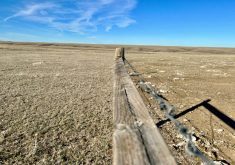It’s no secret that farmland is getting pretty pricey.
The latest data released by Farm Credit Canada shows the average value of farmland in Manitoba increased by 13.9 per cent during the second half of 2012. Nationally, the average value of farmland has increased at the average annual rate of 12 per cent since 2008, about twice the rate of increase from 2002 to 2007.
As investments go, land is a pretty good one. Farmers who own land are seeing their net worth increase without turning a wheel.
Commodity prices have been strong, interest rates low and there’s a deeply rooted rhetoric that says they aren’t making any more of it. Meanwhile, the global demand for food is growing.
Read Also

Your best (and easiest) holiday dainty tray
Make-ahead recipes, store-bought goodies and co-operation with friends and family: Here’s how to throw together a stunning, low-stress tray.
Recent agricultural outlook reports in Canada and the United States suggest that while crop prices are expected to come down from recent highs, prices are projected to remain above historical averages over the next 10 years, the FCC release says. “The outlook for Canadian agriculture is really positive,” notes chief FCC agricultural economist. J.P. Gervais.
So the question becomes, why when their future profitability depends on their soil’s productivity are farmers letting soil simply blow away?
Exceedingly high, gusty winds are becoming a regular occurrence in southern Manitoba during April, May and June. But it is hard to imagine ever becoming accustomed to seeing the midday sky darkened by some of the most expensive dirt in the West.
Events like these underscore a growing concern in scientific circles that modern agricultural practices are not only destroying the soil, they are killing humanity’s last chance of mitigating climate change.
If that sounds like a heavy, it is.
There was a public screening of the British documentary “Humus: the forgotten climate aid,” at the University of Winnipeg earlier this month, just as farmers were literally starting to ‘kick up the dust’ putting this year’s crop in the ground.
“Hidden away beneath our feet is the last chance for our climate,” the narrator warns.
This is a relatively new twist on the linkage between agriculture and global warming. The sector is credited with contributing between 17 and 32 per cent of greenhouse gas emissions globally.
But the decline of humus, not to be confused with the Middle Eastern dip made from chickpeas, refers to the generally declining health of the Earth’s soils, most notably their ability to absorb and store CO2 by converting it into organic matter.
A recent article by Kristin Ohlson in the journal Discover quotes Ohio State University soil scientist Rattan Lal as saying agricultural soils of the world have the potential to soak up 13 per cent of the carbon dioxide in the atmosphere today, which is the equivalent of scrubbing every ounce of CO2 released into the atmosphere since 1982.
In other words, soil could be a powerful tool in stabilizing our climate. In its healthy state, it can store twice as much carbon as the atmosphere. But not the way we’re going about things.
Definitions vary, but soil humus is related to its stability, texture, water-holding capacity and the amount of living organisms such as earthworms, nematodes, protozoa, fungi, bacteria and various arthropods.
It’s only in recent times that researchers have started to characterize the soil as a living entity, instead of a growth medium.
Efforts to understand the connections between how we treat the soil, its health and our climate have intensified along with the frequency of weather-related natural disasters. “Soil research is becoming a matter of survival,” the film tells us.
The premise of this documentary is that tillage and monoculture associated with modern agriculture destroys the soil’s structure. As well, the focus on fertilizing plants with chemical fertilizers rather than feeding the soil kills the micro-organisms responsible for soil’s natural fertility.
The linkages between tillage and soil health are well known. Prairie farmers are among the world leaders in the adoption of no-till farming, not only because it helps keep soil from eroding, but because they have seen continued improvements in productivity due to better moisture retention and fertility. This has increased the diversity of crops they can grow.
However, the suggested link between chemical fertilizer and declining soil health is bound to be met with skepticism.
Building stable humus, or overall soil fertility will take time and quite possibly radical changes in land-management and cropping practices.
But it starts with keeping the dirt beneath our feet — instead of grit between our teeth.













